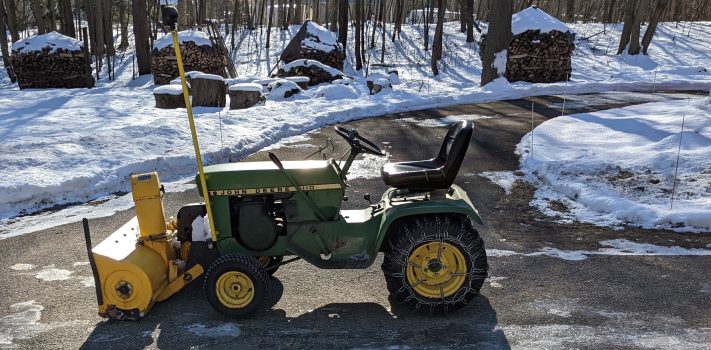The gasoline-powered internal combustion engine is a wonderful invention. It takes the substantial amount of energy stored up in fossil fuels, and makes it conveniently available for the tasks of daily life. Gasoline engines have probably done more to ease the labors of rural living than any other single invention of the last 200 years.
It is possible that I may live to see the day when gasoline-powered equipment is no longer in common use. If that day comes, it will almost certainly not be due to powerful elites looking out for the best interests of the common man. Instead, it will be due to politically well-connected people sacrificing the best interests of the common man in order to advance their own purposes.
The gasoline-powered device that I use the most often and that saves me the most work is probably the automobile. I use a car pretty much every day to get to work, to get to the store, to visit family and friends, and for a host of other transportation-related needs.
The gasoline-powered device that I probably use second most often and that saves me the second most work is probably the chainsaw. If things go south, and gasoline supplies run out, it will be much, much harder to for me to harvest and process the wood that I need to keep my house warm.
The third place prize for gasoline-powered devices would probably go to my 1974 John Deere 110 lawn and garden tractor. I use it primarily to keep my driveway clear of snow throughout the winter. If things go south, and gasoline supplies run out, I guess there won’t be any need to keep my driveway clear of snow anymore. In the meantime, the old John Deere is an outstanding tool.
The Blower
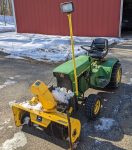 The Snow Blower that I have mounted on the front of the old 110 is a John Deere Model 37A single-stage snow blower attachment. The blower struggles a bit with really wet snow, particularly if temperatures are below freezing. Under those conditions, the wet snow tends to freeze in the chute, causing it to clog. A coating of Turtle Wax paste wax inside the chute can moderate this problem somewhat, but only partially. So, for times when I find the chute clogging too much, I have a two-stage walk-behind snow blower that I use instead. The blower on the tractor is 36 inches wide and the walk-behind blower is only 24 inches wide, so it takes a bit longer to complete the job using the walk-behind. But for the vast majority of the winter, the snow I am clearing is dry and powdery, and the 37A blower on the 110 tractor clears it quite well.
The Snow Blower that I have mounted on the front of the old 110 is a John Deere Model 37A single-stage snow blower attachment. The blower struggles a bit with really wet snow, particularly if temperatures are below freezing. Under those conditions, the wet snow tends to freeze in the chute, causing it to clog. A coating of Turtle Wax paste wax inside the chute can moderate this problem somewhat, but only partially. So, for times when I find the chute clogging too much, I have a two-stage walk-behind snow blower that I use instead. The blower on the tractor is 36 inches wide and the walk-behind blower is only 24 inches wide, so it takes a bit longer to complete the job using the walk-behind. But for the vast majority of the winter, the snow I am clearing is dry and powdery, and the 37A blower on the 110 tractor clears it quite well.
One advantage of a blower in contrast to a plow is that the blower lifts the snow up and over the edge of the driveway, while the plow packs it tightly along the edge of the driveway. With the plow, the driveway has a tendency to narrow gradually over the course of the winter as the tightly packed snow freezes into a hard wall. With the blower, it is easy to keep the driveway open to its full width the entire winter.
Insulated Canvas Coveralls and a Snowmobile Helmet
My 110 doesn’t have an enclosed cab, so protection from the elements while I am blowing snow comes from what I wear. I have a pair of Zero Zone insulated canvas coveralls made by Walls in the USA. I purchased them at a second-hand store for $20. They are large enough that I can pull them on over whatever else I happen to be wearing. If it is warm enough, wearing the coveralls over jeans and a sweater is sufficient. If it is colder, I can add other layers like a goose down vest for extra warmth.
I wear a snowmobile helmet while I am blowing snow to protect my face and head from wind-whipped flakes. I bought the helmet on Craigslist for $25. I can shut the visor if the wind is blowing snow back toward my face, or open it if the wind is blowing in another direction. The helmet helps to muffle some of the excess noise produced by the engine of the tractor as well.
I have a heavy pair of leather, fleece-lined mittens to protect my hands. They are large enough that I can wear a pair of glove liners under them. If I need to do some type of fine adjustment, I can pull off the mittens and wear just the glove liners.
In Norway, there is a saying, “There is no bad weather, just bad clothing.” Wearing the clothing that I have described, I can blow snow in perfect comfort under most weather conditions.
Ease of Repair
One of the things I like best about the 110 is that most of the time if something breaks, I can repair it myself. The mechanical parts are simple and straightforward, there are no electronic parts, there is enough room to get at the various parts without being a contortionist, and spare parts are readily available at my local John Deere dealership.
The Biff Trick
Fans of the Back to the Future movies may remember that Biff Tannen had a trick for starting his 1946 Ford Super De Luxe. Because of the trick, he was only one who could start the car. I guess I have a similar trick with my John Deere 110. The throttle needs to be set about half open. The choke needs to be all the way closed as the ignition key is turned, and then gradually opened as the engine cranks until it catches. It works great for me, but it doesn’t seem to work for anyone else. There is nothing like long-term familiarity with a piece of equipment to help one feel more comfortable using it.
The Fuel Line Shut-Off Valve
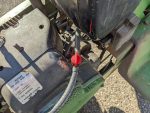 One minor modification that I have made to the John Deere 110 is installing a gas shut-off valve on the fuel line. When I am done running the tractor, I turn off the shut-off valve, and allow the engine to shut down from fuel starvation. Prior to making this change, fuel tended to dribble through the fuel line when the tractor was not operating, causing the carburetor to become gradually dirty and wasting a great deal of fuel. Since I made this change, the carburetor has remained cleaner, and the tractor has been easier to start.
One minor modification that I have made to the John Deere 110 is installing a gas shut-off valve on the fuel line. When I am done running the tractor, I turn off the shut-off valve, and allow the engine to shut down from fuel starvation. Prior to making this change, fuel tended to dribble through the fuel line when the tractor was not operating, causing the carburetor to become gradually dirty and wasting a great deal of fuel. Since I made this change, the carburetor has remained cleaner, and the tractor has been easier to start.
The Headlight
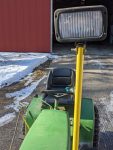 Another modification was mounting a LED headlight on a pole near the front of the tractor. Most of the time during the winter, it is dark when I need to clear snow. The nice bright headlight makes it much easier for me to see what I am doing, and makes it easier for passing cars to see me if I am working near the road at the end of the driveway. The pole is probably a little taller than I actually need, but it works well, so I am leaving well enough alone.
Another modification was mounting a LED headlight on a pole near the front of the tractor. Most of the time during the winter, it is dark when I need to clear snow. The nice bright headlight makes it much easier for me to see what I am doing, and makes it easier for passing cars to see me if I am working near the road at the end of the driveway. The pole is probably a little taller than I actually need, but it works well, so I am leaving well enough alone.
The “Grillwork”
When I first bought the tractor, it did not have any grillwork at the front of the engine housing. Snow tended to drift in from the blower, and collect at various points in the engine, where it could freeze, creating problems. I took a sheet of barn steel, cut it to size, painted it black, and inserted it into the slot previously occupied by the missing grillwork. The sheet of barn steel keeps the blowing snow out of the engine, thus allowing the tractor to operate more reliably under the harshest conditions.
The Trickle Charger
I added a DC plug to the circuit of my 110, and use it to keep the tractor plugged into a trickle charger when it is not in use. This keeps the battery fully charged, ready to crank the engine whenever it is needed.
My modifications to the tractor are utilitarian rather than cosmetic. The old 110 may look well broken in, and even slightly battered, but it functions extremely well.
The History of the John Deere 110
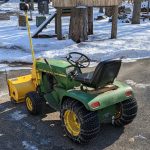 The John Deere 110 was the company’s first entry into the lawn and garden tractor market. It was introduced in 1963, and remained in production for the next 11 years, making my 1974 version one of the later models in production. All of the various models were powered by Kohler cast iron engines, which have a very good record for durability and reliability. The earliest models were seven horsepower, while later models were eight or ten horsepower.
The John Deere 110 was the company’s first entry into the lawn and garden tractor market. It was introduced in 1963, and remained in production for the next 11 years, making my 1974 version one of the later models in production. All of the various models were powered by Kohler cast iron engines, which have a very good record for durability and reliability. The earliest models were seven horsepower, while later models were eight or ten horsepower.
The design became so iconic that a John Deere 110 now resides at the Smithsonian Institution’s National Museum of American History in Washington D.C.
Conclusion
Sometimes older equipment can be more rugged and reliable than some of its more modern replacements. I have found my John Deere 110 to be an excellent piece of older equipment.
If you need a good tool for clearing snow from a longish driveway, then finding a used, but good-condition John Deere 110 coupled with a John Deere 37a snow blower attachment may be a good solution for you.
Disclaimer
I did not receive any financial or other inducements to mention any vendor, product, or service in this article.

